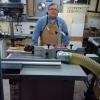On my list of projects is to dabble with producing some electricity with a wind turbine and a water wheel. Not wanting to generate much power, just want to power several strings of led landscaping lights.
The heart of these projects is the design and build of an alternator. I'm thinking maybe something in the 6" to 8" diameter size. I have searched a good bit and have found several videos and articles on the subject. However, I have yet to find anything that explains how the math works for an efficient design. The variables are numerous, magnet size and strength, coil wire size, number of windings per coil, anticipated rpm, clearance between magnets and coils,etc. I am hoping to find maybe a chart or a list of formulas with explanations on how the math works.
Anybody done this before or care to educate this mechanical engineer who struggles at times with electrical theory.
Thanks,
Perry




 Reply With Quote
Reply With Quote




